A Canadian exhibition guy named Robert Wales says the reason Match Point sounded so shitty at the Leows Lincoln Square on Wednesday night is because Woody Allen is an old fart when it comes to state-of-the-art sound recording. “Are you aware that Allen has never made a film in stereo?,” Wales begins. “There are going to be differences comparing a big film with a full 5-channel mix to one of Allen’s dialogue-driven pieces. I work for a major theatre chain, and every Allen film inevitably brings us customer complaints about presentation that are almost always related to the fact that they feel they are being cheated because the sound is coming from only one speaker, and therefore something must be wrong. The situation is even murkier when people see the film being presented in digital sound, which to the average person means multi-channel. The truth is that digital sound is able to convey as many (or as few ) channels as the filmmakers intended. I haven’t seen Match Point myself, but I have no reason to expect that Allen has suddenly decided to mix his films in stereo at this stage in his career. Of course, it’s also possible you saw a lousy presentation but given the prominence of Leows’ Lincoln Square I’d be surprised if their presentations were truly substandard.”
I love the term “Fandango paranoia” because I know what it is…I’ve been there myself. It’s defined by New York Times reporter Ben Sisario in a 12.30 story as “[Fandango ticket] purchases made far ahead in the expectation of others chasing after the same limited pool of tickets.” There’s also “Fandango depression,” which results when a given show doesn’t sell out and thus the Fandango purchaser has paid an unnecessary surcharge. “I always feel ripped off when I pay the surcharge and then there are empty seats,” Sisario is told by a gay (i.e., has a “partner”) legal research guy.
Oh-Six Starters
There are four January releases that definitely cut the mustard in my pantry, and two or three with one or two problems but are recommended regardless. So things are starting off reasonably well. For a month known for so-so product, I mean.
The absolute must-see’s are Lajos Koltai’s Fateless (Thinkfilm, 1.6), Eugene Jarecki’s Why We Fight (Sony Pictures Classics, 1.20), Steven Soderbergh’s Bubble (Magnolia, 1.27) and Michael Winterbottom’s Tristram Shandy: A Cock and Bull Story (Picturehouse, 1.27).
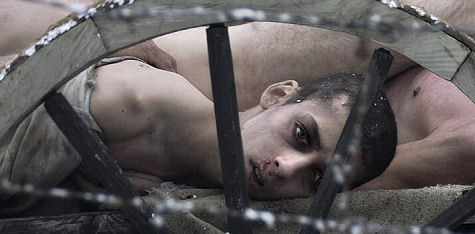
From Lajos Koltai’s Fateless (and not what it seems to be)
The not-bad-with-reservations in order of preference are Ol Parker’s Imagine Me and You (Fox Searchlight, 1.27), Albert Brooks’ Looking for Comedy in the Muslim World (Warner Bros., 1.20) and Lars von Trier’s Manderlay (IFC Films, 1.27).
I’ve seen some others and can riff a bit about them, but aside from these six or seven we all know what January is about. That is, if you aren’t priveleged or con- nected enough to go to Sundance and you pay to see new movies in your local plex. It’s about feeling vaguely burned.
< ?php include ('/home/hollyw9/public_html/wired'); ?>
Or it’s about catching up with Xmas films and watching more DVDs than usual or maybe picking up a book…but the mood that settles over a multiplex in January is rarely expectant, much less electric.
Here’s what I know, have heard or am deducing thus far…
January 6: Fateless is the first near-great film of 2006. The exquisite widescreen framing, desaturated color and exquisite editing make it, to my eyes, the most visually immaculate Holocaust death-camp drama ever made (does that sound right?) as well as one of the most realistic seeming and subtly-rendered in terms of story.
Based on Imre Kertesz’s mostly true-life account, it’s about a young Jewish boy from Budapest who ends up in a concentration camp during World War II and just barely survives. It lacks the story tension and rooting factor of Polanski’s The Pianist, but situations of hunger, despair and the ashy aura of near-death have never been rendered with such remarkable pictorial finesse.

Otherwise, I’ve been told by a young guy I completely trust that Grandma’s Boy is absolutely atrocious. I don’t know about BloodRayne except for the hot babe in the poster. I’ve seen the Hostel trailer and that’s as far as I go. Not a very brave or engaging attitude, I’ll admit. (I generally loathe horror films even though I rather liked Wolf Creek, which so many other critics were deeply offended by.)
January 13: The only one I’ve seen is Laurence Dunmore’s The Libertine (Weinstein Co.) and the less said about it, the better. Johnny Depp is utterly dislikable as a smart but self-destructive Old World asshole named John Wilmot, the second Earl of Rochester. Muddy, desaturated color…gobs of period detail without no discernible spark of life…an almost completely detestable film.
The trailer for Kevin Reynolds’ Tristan & Isolde (20th Century Fox)…oh, no….oh, no….Rufus Sewell is in it. I’m sorry but that tears it. And please…not another swords-and-horses romantic triangle King Arthur– slash-First Knight-type thing. How can studio executives greenlight this stuff and still look at themselves in the mirror?
James Franco (Tristan) is a very fine and charismatic actor who can’t seem to catch a wave, much less a break. (He’s also in Justin Lin’s Annapolis, opening on 1.27.) Sophia Myles, whom I liked in Art School Confidential, is a very intelligent, seemingly passionate actress with a very chubby moon face. Curvy, not-slim actresses are becoming more and more common these days, but there haven’t been any high-wattage moon-faced actresses since the days of Theda Bara.
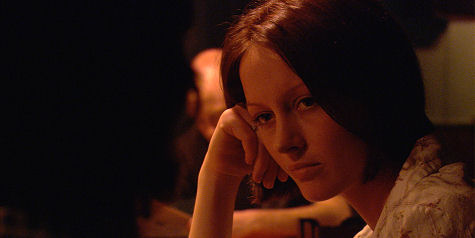
Misty Wilkins, hot-stuff star of Steven Soderbergh’s Bubble
And zipposky on April’s Shower, Glory Road, Hoodwinked, Last Holiday, On The Outs.
January 20: Eugene Jarecki’s Why We Fight is not just the best film being released on this date but sure to be listed among the year’s (and probably the decade’s) finest also. A brilliantly told history of America’s military industrial complex and war machine. And very well made…well paced…totally blue-chip all the way. John McCain, Gore Vidal, William Kristol, Chalmers Johnson and Richard Perle are among the talking heads.
There are good things — more than a few good things — in Albert Brooks’ Looking for Comedy in the Muslim World (Warner Bros.). It’s dry and disciplined and somewhat amusing here and there, but it has an older guy’s energy levels and — frankly? — not that great a story.
You’d think a movie about what makes Muslims laugh would at least take a stab at answering this question. And it would have worked better if Brooks (playing himself) had somehow managed to visit the real Muslim world (Iraq, Saudi Arabia, Jordan, et. al.) instead of India, where most of this film takes place.
India is not where the terrorists are. Call for tech support and a very polite idiot who knows absolutely nothing about how to help you with your problem…that‘s India.
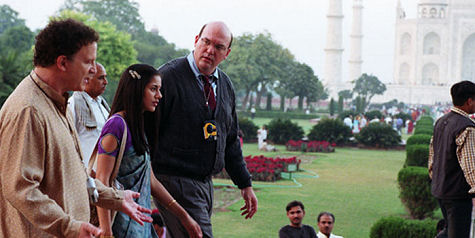
Albert Brooks (l.) in Looking for Comedy in the Muslim World
You know that Underworld: Evolution (Screen Gems), the Underword sequel, is solely about trying to grab a portion of the $100 million earned by the original. With Kate Beckinsdale and Scott Speedman reprising their roles, what are the odds of this being any more that the usual breathy-moldy-sexy CGI vampire-werewolf crap?
The trailer certainly gives every indication it’s a straight programmer and strictly a paycheck movie for the talent. If it rises even a tiny bit above the level of pure bilge I will buy a red rubber enema bag and do the appropriate thing.
Nothing about End of the Spear, Pizza, The Real Dirt on Farmer John.
January 27: Bubble is a minimalist murder tale from Steven Soderbergh, shot on video with non-pro actors. It’s a very clean, creepy and absorbing piece. It’s modest but damn fine within its perimeter. I consider Bubble Soderbergh’s return to form — the first high-grade wow thing he’s done since Traffic.
I wrote during the Toronto Film Festival that “as far as I’m concerned Bubble, a heart-of-proletariat-darkness drama, is reason to pop open the champagne and breathe easy. Soderbergh was falling off the horse repeatedly with Full Frontal, Solaris and the two Ocean‘s movies…but he hunkered down and stayed with the process and that constant-state-of-becoming trip that all artists need to be into, and now he’s back.”
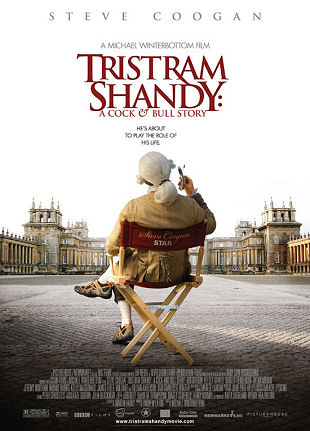
Oh Parker’s Imagine Me and You, which I saw at Toronto, is one of those rotely British romantic confections, although nowhere near as sickening as Love Actually and for the most part a reasonably decent and even (at times) touching thing.
It’s about a woman (Piper Parabo) who falls in love with another woman (Lena Headley) on her wedding day…which leaves her husband Heck (Matthew Goode) confused and out in the cold. It’s formulaic and tidy, although at times I could feel the capability on Parker’s part (if not the willingness) to make a complex adult relationship drama along the lines of John Schlesinger’s Sunday Bloody Sunday.
I didn’t hear a single unkind word about Tristram Shandy: A Cock and Bull Story during the Toronto Film Festival, so even though I didn’t see it myself it seems like a reasonably safe call to put it on the recommend list.
It’s basically the bone-dry British funnyman Steve Coogan starring in some kind of smart-ass variation of Karel Reisz’s The French Lieutenant’s Woman (1982). It’s a film about the making of an historical film — an adaptation of Laurence Stern’s “The Life and Opinions of Tristram Sahndy, Gentlemen” — while at the same time a look at the historical characters as well as the actors portraying them.

Willem Dafoe, Bryce Dallas Howard in Lars von Trier’s Manderlay
After seeing Lars von Trier’s Manderlay in Cannes last May I wrote that “it didn’t do it for me, and I’m speaking as a totally ardent fan of von Trier’s Dogville, Dancer in the Dark and Breaking the Waves, as well as being a general fool for his bad-boy provocations.
“It’s a relentlessly talky, intelligent and provocative film that addresses…well, American racism, certainly, but more generally a do-gooder tendency by American governments to try and shape other societies so they more resemble our own (Iraq, Vietnam, etc.). And it indulges in the usual proddings and agitations that are par for this Danish filmmaker.
“The second installment in von Trier’s America trilogy, Manderlay is a continuation of the adventures of Grace, the gangster’s daughter played by Nicole Kidman in Dogville, the trilogy’s 2003 kickoff, and by Bryce Dallas Howard in the new film.
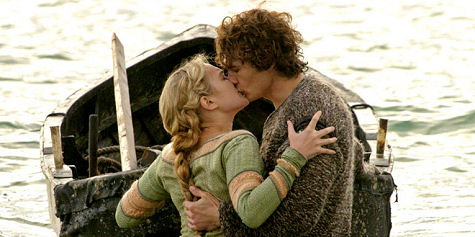
Sophia Miles, James Franco in Kevin Reynolds’ Tristan and Isolde
“Both films are stagey and pedantically inclined, and shot on what is probably the same massive sound stage with imaginary props and sets. (The third installment will presumably follow suit.)
“Manderlay is too similar to Dogville and not similar enough. Despite its slow pace and too-gradual plot development, Dogville had a surprise revelation (Kidman is the daughter of gangster James Caan, and not his girlfriend, as the film allows us to assume at first) and a shockingly violent finale that expressed von Trier’s negative feelings about what he sees as American tendencies to exploit the less fortunate.
“Like Dogville it’s broken up by titled chapters, John Hurt again provides the dry and pungent narration, and the closing credit sequence is nearly identical with the same David Bowie song (‘Young Americans’) played over a series of stills that illuminate the uglier aspects of America’s history — in this instance the treatment of African-Americans over the last century or so.
“But there’s no big jolt or surprise at the finale — you can pretty much tell what’s coming from the get-go — and it so closely recalls Dogville‘s aching-butt aspects that watching it feels like a chore.
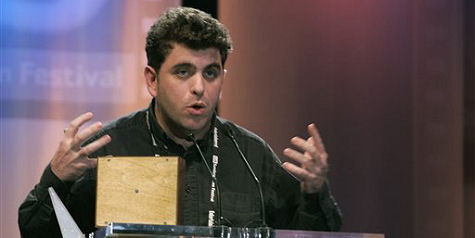
Eugene Jarecki discussing Why We Fight at the 2005 Sundance Film Festival
Otherwise…
Annapolis isn’t a precise revisiting of An Officer and a Gentleman but it’s obviously on similar turf with the element of boxing thrown in. Annapolis, boxing…Annapolis, boxing. Better Luck Tomorrow helmer Justin Lin is the director, and I should just keep my mouth shut until I see it.
Big Momma’s House 2 can have coitus with itself. Breaking News looks to me like a standard-issue Hong Kong cop thriller, and I’m not vigorous enough to try and figure the real truth of it. Mirage, Nanny McPhee and the IMAX film Roving Mars haven’t yet come into focus.
You don’t have confuse Tristram Shandy with Tristan and Isolde — “Tristram” has two r’s and the movie is fairly jaunty and flip, and the other one is bold-faced sincere.
Grabs
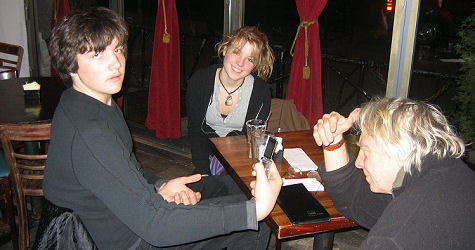
(l. to r.) Occasional Hollywood Elsewhere columnist Dylan Wells, Becca Payne and producer-screenwriter L.M. Kit Carson at Columbia student bar at Broadway and 113th Street — Tuesday, 12.27, 10:15 pm

On IRT Lexington uptown — Saturday, 12.24, 3:10 pm.

Troubador in waiting area for Union Square L line to Brooklyn — Monday, 12.26, 11:25 pm.

$30 jar of ginger orange foam scrub, purchased at Sabon on Spring Street on Sunday, 12.25, 8:40 pm.
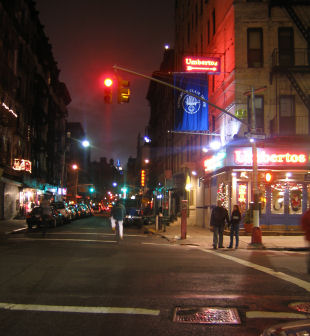
Mott Street in Little Italy — Thursday, 12.29, 8:20 pm.
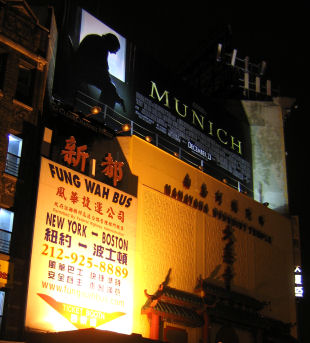
Canal Street near Manhattan Bridge — Thursday, 12.29, 7:15 pm.

Grand Central Station — Tuesday, 12.27, 4:25 pm.

On L train heading to Brooklyn — Tuesday, 1.27, 11:45 pm

What would Nic Cage (or a character played by him), Joan of Arc and Oliver Reed’s “Father Grandier” character in The Devils have in common? Something, I think…unless Neil Labute has decided to re-shuffle the story of The Wicker Man.

Thurday, 12.29, 8:15 pm.
Herzog vs. Huffman
“Thanks for celebrating Werner Herzog, the most amazing director working today. However…
“While I don’t disagree with you and Time‘s Richard Corliss for celebrating his little seen recent, wonderful documentary The White Diamond, I wonder if you were aware just how contrived the film is.
“Recently Herzog was in Seattle for a short festival of some of his recent films and in the q & a session afterwards he explained that pretty much everything said in the interview sessions in the film (particularly from the talkative local man who owned the rooster) was completely scripted.
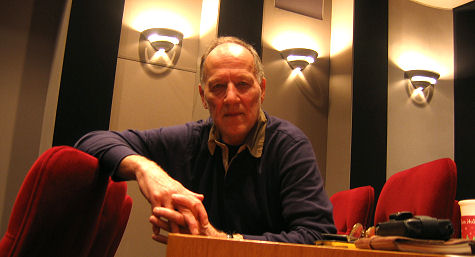
“Herzog said it in way that made it seem like he would be stunned if anyone could possibly think it was done any other way. He described in detail how he wrote complete speeches for the folks and how they would struggle to deliver them (the speeches are basically based on his conversations with the interviewees and Herzog’s own thoughts).
“If anything, knowing that this is how Herzog constructs his documentaries makes me like them even more. All documentaries are a succession of lies that form a particular person’s greater truth. I am just surprised that Herzog seemed to assume that everyone else was in on the secret.” — Richard Huffman, Seattle, WA.
Werner Herzog replies: “Jeffrey — [Huffman’s] questions about The White Diamond are too simplified. Why would I who postulates a cinema where you can trust your eyes again (Fitzcarraldo) ‘concoct’ elements of his ‘documentaries’?
“My inventions and stylizations aim to penetrate into a deeper truth, whereas Reality TV only pretends to depict the ‘real’ but captures just facts, and not truth.
“I have to be more precise to distinguish between two major issues:
“1. Whenever it comes to visual material, I want audiences to trust their eyes again, like the ship over a mountain (Fitzcarraldo). When I use a digital effect, like at the end of Invincible where the strongman’s kid brother flies away across the ocean: it is so obvious, and so stylized, and embedded in the dialogue that it is no contradiction to what I like to achieve.
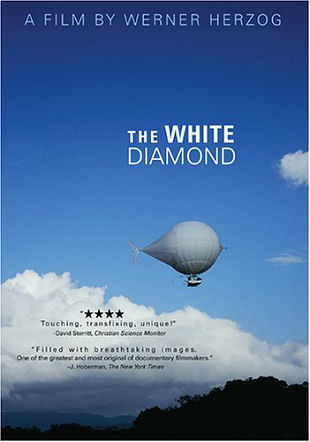
“I welcome the recreation of dinosaurs on the screen.
“Equally: everything which constitutes the hardcore identity of a protagonist in my “documentaries” I would not touch (Littlre Dieter Needs to Fly, Grizzlly Man, Wings of Hope, etc.). However, I do invent Dieter’s dreams, and I do stage elements of his character (otherwise not visible), like Dieter opening and closing the door of his home. This is the ecstatic truth of his existence.
“2. Whatever I can do to get beyond the mere facts…to get deeper into a story of a ‘documentary’…to grasp a truth in its ecstatic state, I will do. The story of Graham Dorrington remains untouched, the catastrophy which befell Dieter Plage, the cinematographer, during his maiden flight on board Dorrington’s airship, happened as narrated, yet: I liked a seemingly unimportant side figure, Mark Anthony Jhap so much that I manoeuvred him more and more into the center – or rather epicenter – of the film. The leading character shifts from Dorrington to Mark Anthony, and at the end to Mark Anthony’s splendid rooster.
“The scene where Mark Anthony leads the camera during his foraging trip to the waterfall, watching it through one single drop of water, is completely scripted, and staged, and rehearsed. From off camera I am asking the most insipid New Age question: ‘Mark Anthony, do you see a whole universe in one single drop of water’, and Mark Anthony turns around with a slight smirk on his face, and responds: ‘I cannot hear what you say for the thunder that you are.’ I believe I shot the scene 5 or 6 times until I got the right, almost imperceptible smirk.
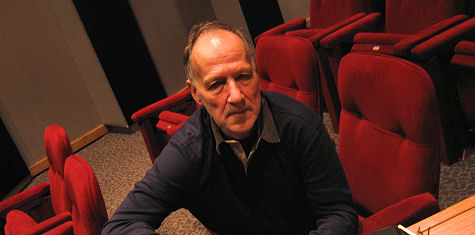
“Mark Anthony’s sentence appears verbatim in a previous film,
“What you and your audience also should be aware of is the fact that the drop of water was not water, but glycerin which has better properties for filming. Klaus Scheurich, a very accomplished wildlife cinematographer, shot this drop of ‘water’ with the inverted waterfall caught in it, and this — at first sight — looked like kitsch, but I got hooked to the image, and I was convinced that this waterdrop embedded in an environment of sheer fantasy would assume a different, a higher, an ecstatic quality.
“I think that this delicate line between reality, and fact, and truth needs to be more clearly defined. My Minnesota Declaration (you’ll find it on my website) does this. But what has to be made more clear is: with the onslaught of virtual realities WE HAVE TO RE-DEFINE REALITY: beyond Cinema Verite, beyond the documen- taries we usually see on TV, beyond the terrain which is not solid any longer, as if we were treading on thin ice.” – Werner Herzog
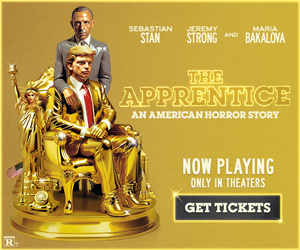
Here are two bona fide Terrence Malick quotes — reported only today and uttered only last Monday — about his direction of The New World and thoughts about his future filmmaking plans. Quote #1: √¢‚Ǩ‚Ñ¢√É‚Äû√ɬ∫I knew [The New World] would have a slow, rolling pace. Just get into it; let it roll over you. It’s more of an experience film. I leave you to fend for yourself, figure things out yourself.√¢‚Ǩ‚Ñ¢√É‚Äû√ɬπ Quote #2: “There’s a good many pictures I’d like to make…we’ll see how many I’ll be allowed to make.” The quotes are significant because Malick never talks to the press. They come from reporter Susan Albert in a story in the Bartlesville, Oklahoma Examiner Enterprise, and were taken from an appearance that Malick made following a screening last Monday of The New World at the Theater Bartlesville. Malick was allegedly raised in or near Bartlesville, which is the headquarters of ConocoPhillips. Malick’s dad reportedly used to work for ConocoPhillips, hence the location.
Screenwriter Josh Friedman (David Koepp nemesis and co- scripter of War of the Worlds, The Black Dahlia) almost worked on Snakes on a Plane and might have…well, who knows what he might have added to the damn thing?…but he really wanted to polish the sucker, but he didn’t see eye-to-eye with some Machiavellian ass-head New Line production executive who is almost certain to shoot himself in the mouth before the year 2010 and the idea went south. Friedman has a blog and here’s his story about what happened…..Snakes on a Plane!…Snakes on a Motherfucking Plane!
Oh-Six Starters
There are four January releases that definitely cut the mustard in my pantry, and two or three with one or two problems but are recommended regardless. So things are starting off reasonably well. For a month known for so-so product, I mean.
The absolute must-see’s are Lajos Koltai’s Fateless (Thinkfilm, 1.6), Eugene Jarecki’s Why We Fight (Sony Pictures Classics, 1.20), Steven Soderbergh’s Bubble (Magnolia, 1.27) and Michael Winterbottom’s Tristram Shandy: A Cock and Bull Story (Picturehouse, 1.27).

From Lajos Koltai’s Fateless (and not what it seems to be)
The not-bad-with-reservations in order of preference are Ol Parker’s Imagine Me and You (Fox Searchlight, 1.27), Albert Brooks’ Looking for Comedy in the Muslim World (Warner Bros., 1.20) and Lars von Trier’s Manderlay (IFC Films, 1.27).
I’ve seen some others and can riff a bit about them, but aside from these six or seven we all know what January is about. That is, if you aren’t priveleged or con- nected enough to go to Sundance and you pay to see new movies in your local plex. It’s about feeling vaguely burned.
< ?php include ('/home/hollyw9/public_html/wired'); ?>
Or it’s about catching up with Xmas films and watching more DVDs than usual or maybe picking up a book…but the mood that settles over a multiplex in January is rarely expectant, much less electric.
Here’s what I know, have heard or am deducing thus far…
January 6: Fateless is the first near-great film of 2006. The exquisite wide-screen framing, destaurated color and exquisite editing make it, to my eyes, the most visually immaculate Holocaust death-camp drama ever made as well as one of the most realistic seeming and subtly-rendered in terms of story.
Based on Imre Kertesz’s mostly true-life account, it’s about a young Jewish boy from Budapest who ends up in a concentration camp during World War II and just barely survives. It lacks the story tension and rooting factor of Polanski’s The Pianist, but situations of hunger, despair and the ashy aura of near-death have never been rendered with such remarkable pictorial finesse.

Otherwise, I’ve been told by a young guy I completely trust that Grandma’s Boy is absolutely atrocious. I don’t know about BloodRayne except for the hot babe in the poster. I’ve seen the Hostel trailer and that’s as far as I go. Not a very brave or engaging attitude, I’ll admit. (I generally loathe horror films even though I rather liked Wolf Creek, which so many other critics were deeply offended by.)
January 13: The only one I’ve seen is Laurence Dunmore’s The Libertine (Weinstein Co.) and the less said about it, the better. Johnny Depp is utterly dislikable as a smart but self-destructive Old World asshole named John Wilmot, the second Earl of Rochester. Muddy, desaturated color…gobs of period detail without no discernible spark of life…an almost completely detestable film.
The trailer for Kevin Reynolds’ Tristan & Isolde (20th Century Fox)…oh, no….oh, no….Rufus Sewell is in it. I’m sorry but that tears it. And please…not another swords-and-horses romantic triangle King Arthur– slash-First Knight-type deal. How can studio executives greenlight these things and still look themselves in the mirror?
James Franco (Tristan) is a very fine and charismatic actor who can’t seem to catch a wave, much less a break. (He’s also in Justin Lin’s Annapolis, opening on 1.27.) Sophia Myles, whom I liked in Art School Confidential, is a very intelligent, seemingly passionate actress with a very chubby moon face. Curvy, not-slim actresses are becoming more and more common these days, but there haven’t been any high-wattage moon-faced actresses since the days of Theda Bara.

Misty Wilkins, hot-stuff star of Steven Soderbergh’s Bubble
And zipposky on April’s Shower, Glory Road, Hoodwinked, Last Holiday, On The Outs.
January 20: Eugene Jarecki’s Why We Fight is not just the best film being released on this date but sure to be listed among the year’s (and probably the decade’s) finest also. A brilliantly told history of America’s military industrial complex and war machine. And very well made…well paced…totally blue-chip all the way. John McCain, Gore Vidal, William Kristol, Chalmers Johnson and Richard Perle are among the talking heads.
There are good things — more than a few good things — in Albert Brooks’ Looking for Comedy in the Muslim World (Warner Bros.). It’s dry and disciplined and somewhat amusing here and there, but it has an older guy’s energy levels and — frankly? — not that great a story.
You’d think a movie about what makes Muslims laugh would at least take a stab at answering this question. And it would have worked better if Brooks (playing himself) had somehow managed to visit the real Muslim world (Iraq, Saudi Arabia, Jordan, et. al.) instead of India, where most of this film takes place. India is not where the terrorists are. Call for tech support and a very polite idiot who knows absolutely nothing about how to help you with your problem…that‘s India.

Albert Brooks (l.) in Looking for Comedy in the Muslim World
You know what Underworld: Evolution (Screen Gems), the Underword sequel, is just a cynical money grab because Underworld made $100 million or so. It looks to me like more breathy-moldy-sexy CGI vampire-werewolf crap with Kate Beckinsdale and Scott Speedman.
The trailer certainly gives every indication it’s a programmer and strictly a paycheck movie for the talent. If it rises even a tiny bit above the level of pure bilge I will buy a red rubber enema bag and do the appropriate thing.
Nothing about End of the Spear, Pizza, The Real Dirt on Farmer John.
January 27: Bubble is a minimalist murder tale from Steven Soderbergh, shot on video with non-pro actors. It’s a very clean, creepy and absorbing piece. It’s modest but damn fine within its perimeter. I consider Bubble Soderbergh’s return to form — the first high-grade wow thing he’s done since Traffic.
I wrote during the Toronto Film Festival that “as far as I’m concerned Bubble, a heart-of-proletariat-darkness drama, is reason to pop open the champagne and breathe easy. Soderbergh was falling off the horse repeatedly with Full Frontal, Solaris and the two Ocean‘s movies…but he hunkered down and stayed with the process and that constant-state-of-becoming trip that all artists need to be into, and now he’s back.”

Oh Parker’s Imagine Me and You, which I saw at Toronto, is one of those rotely British romantic confections, although nowhere near as sickening as Love Actually and for the most part a reasonably decent and even (at times) touching thing.
It’s about a woman (Piper Parabo) who falls in love with another woman (Lena Headley) on her wedding day…which leaves her husband Heck (Matthew Goode) confused and out in the cold. It’s formulaic and tidy, although at times I could feel the capability on Parker’s part (if not the willingness) to make a complex adult relationship drama along the lines of John Schlesinger’s Sunday Bloody Sunday.
I didn’t hear a single unkind word about Tristram Shandy: A Cock and Bull Story during the Toronto Film Festival, so even though I didn’t see it myself it seems like a reasonably safe call to put it on the recommend list.
It’s basically the bone-dry British funnyman Steve Coogan starring in some kind of smart-ass variation of Karel Reisz’s The French Lieutenant’s Woman (1982). It’s a film about the making of an historical film — an adaptation of Laurence Stern’s “The Life and Opinions of Tristram Sahndy, Gentlemen” — while at the same time a look at the historical characters as well as the actors portraying them.

Willem Dafoe, Bryce Dallas Howard in Lars von Trier’s Manderlay
After seeing Lars von Trier’s Manderlay in Cannes last May I wrote that “it didn’t do it for me, and I’m speaking as a totally ardent fan of von Trier’s Dogville, Dancer in the Dark and Breaking the Waves, as well as being a general fool for his bad-boy provocations.
“It’s a relentlessly talky, intelligent and provocative film that addresses…well, American racism, certainly, but more generally a do-gooder tendency by American governments to try and shape other societies so they more resemble our own (Iraq, Vietnam, etc.). And it indulges in the usual proddings and agitations that are par for this Danish filmmaker.
“The second installment in von Trier’s America trilogy, Manderlay is a continuation of the adventures of Grace, the gangster’s daughter played by Nicole Kidman in Dogville, the trilogy’s 2003 kickoff, and by Bryce Dallas Howard in the new film.

Sophia Miles, James Franco in Kevin Reynolds’ Tristan and Isolde
“Both films are stagey and pedantically inclined, and shot on what is probably the same massive sound stage with imaginary props and sets. (The third installment will presumably follow suit.)
“Manderlay is too similar to Dogville and not similar enough. Despite its slow pace and too-gradual plot development, Dogville had a surprise revelation (Kidman is the daughter of gangster James Caan, and not his girlfriend, as the film allows us to assume at first) and a shockingly violent finale that expressed von Trier’s negative feelings about what he sees as American tendencies to exploit the less fortunate.
“Manderlay is obviously man to play as a Dogville companion. It is broken up by titled chapters, John Hurt again provides the dry and pungent narration, and the closing credit sequence is nearly identical with the same David Bowie song (‘Young Americans’) played over a series of stills that illuminate the uglier aspects of America’s history — in this instance the treatment of African-Americans over the last century or so.
“But there’s no big jolt or surprise at the finale — you can pretty much tell what’s coming from the get-go — and it so closely recalls Dogville‘s aching-butt aspects that watching it feels like a chore.

Eugene Jarecki discussing Why We Fight at the 2005 Sundance Film Festival
Otherwise…
Annapolis isn’t a precise revisiting of An Officer and a Gentleman but it’s obviously on similar turf with the element of boxing thrown in. Annapolis, boxing…Anapolis, boxing. Better Luck Tomorrow helmer Justin Lin is the director, and I should keep my mouth shut until I see it.
Big Momma’s House 2 can have coitus with itself. Breaking News looks to me like a standard-issue Hong Kong cop thriller, and I’m not vigorous enough to try and figure the real truth of it. Mirage, Nanny McPhee and the IMAX film Roving Mars haven’t yet come into focus.
You don’t have confuse Tristram Shandy with Tristan and Isolde — “Tristram” has two r’s and the movie is fairly jaunty and flip, and the other one is bold-faced sincere.
Grabs

(l. to r.) Occasional Hollywood Elsewhere columnist Dylan Wells, Becca Payne and producer-screenwriter L.M. Kit Carson at Columbia student bar at Broadway and 113th Street — Tuesday, 12.27, 10:15 pm

On IRT Lexington uptown — Saturday, 12.24, 3:10 pm.

Troubador in waiting area for Union Square L line to Brooklyn — Monday, 12.26, 11:25 pm.

$30 jar of ginger orange foam scrub, purchased at Sabon on Spring Street on Sunday, 12.25, 8:40 pm.

Mott Street in Little Italy — Thursday, 12.29, 8:20 pm.

Canal Street near Manhattan Bridge — Thursday, 12.29, 7:15 pm.

Grand Central Station — Tuesday, 12.27, 4:25 pm.

On L train heading to Brooklyn — Tuesday, 1.27, 11:45 pm

What would Nic Cage (or a character played by him), Joan of Arc and Oliver Reed’s “Father Grandier” character in The Devils have in common? Something, I think…unless Neil Labute has decided to re-shuffle the story of The Wicker Man.

Thurday, 12.29, 8:15 pm.
Herzog vs. Huffman
“Thanks for celebrating Werner Herzog, the most amazing director working today. However…
“While I don’t disagree with you and Time‘s Richard Corliss for celebrating his little seen recent, wonderful documentary The White Diamond, I wonder if you were aware just how contrived the film is.
“Recently Herzog was in Seattle for a short festival of some of his recent films and in the q & a session afterwards he explained that pretty much everything said in the interview sessions in the film (particularly from the talkative local man who owned the rooster) was completely scripted.

“Herzog said it in way that made it seem like he would be stunned if anyone could possibly think it was done any other way. He described in detail how he wrote complete speeches for the folks and how they would struggle to deliver them (the speeches are basically based on his conversations with the interviewees and Herzog’s own thoughts).
“If anything, knowing that this is how Herzog constructs his documentaries makes me like them even more. All documentaries are a succession of lies that form a particular person’s greater truth. I am just surprised that Herzog seemed to assume that everyone else was in on the secret.” — Richard Huffman, Seattle, WA.
Werner Herzog replies: “Jeffrey — [Huffman’s] questions about The White Diamond are too simplified. Why would I who postulates a cinema where you can trust your eyes again (Fitzcarraldo) ‘concoct’ elements of his ‘documentaries’?
“My inventions and stylizations aim to penetrate into a deeper truth, whereas Reality TV only pretends to depict the ‘real’ but captures just facts, and not truth.
“I have to be more precise to distinguish between two major issues:
“1. Whenever it comes to visual material, I want audiences to trust their eyes again, like the ship over a mountain (Fitzcarraldo). When I use a digital effect, like at the end of Invincible where the strongman’s kid brother flies away across the ocean: it is so obvious, and so stylized, and embedded in the dialogue that it is no contradiction to what I like to achieve.

“I welcome the recreation of dinosaurs on the screen.
“Equally: everything which constitutes the hardcore identity of a protagonist in my “documentaries” I would not touch (Littlre Dieter Needs to Fly, Grizzlly Man, Wings of Hope, etc.). However, I do invent Dieter’s dreams, and I do stage elements of his character (otherwise not visible), like Dieter opening and closing the door of his home. This is the ecstatic truth of his existence.
“2. Whatever I can do to get beyond the mere facts…to get deeper into a story of a ‘documentary’…to grasp a truth in its ecstatic state, I will do. The story of Graham Dorrington remains untouched, the catastrophy which befell Dieter Plage, the cinematographer, during his maiden flight on board Dorrington’s airship, happened as narrated, yet: I liked a seemingly unimportant side figure, Mark Anthony Jhap so much that I manoeuvred him more and more into the center – or rather epicenter – of the film. The leading character shifts from Dorrington to Mark Anthony, and at the end to Mark Anthony’s splendid rooster.
“The scene where Mark Anthony leads the camera during his foraging trip to the waterfall, watching it through one single drop of water, is completely scripted, and staged, and rehearsed. From off camera I am asking the most insipid New Age question: ‘Mark Anthony, do you see a whole universe in one single drop of water’, and Mark Anthony turns around with a slight smirk on his face, and responds: ‘I cannot hear what you say for the thunder that you are.’ I believe I shot the scene 5 or 6 times until I got the right, almost imperceptible smirk.

“Mark Anthony’s sentence appears verbatim in a previous film,
“What you and your audience also should be aware of is the fact that the drop of water was not water, but glycerin which has better properties for filming. Klaus Scheurich, a very accomplished wildlife cinematographer, shot this drop of ‘water’ with the inverted waterfall caught in it, and this — at first sight — looked like kitsch, but I got hooked to the image, and I was convinced that this waterdrop embedded in an environment of sheer fantasy would assume a different, a higher, an ecstatic quality.
“I think that this delicate line between reality, and fact, and truth needs to be more clearly defined. My Minnesota Declaration (you’ll find it on my website) does this. But what has to be made more clear is: with the onslaught of virtual realities WE HAVE TO RE-DEFINE REALITY: beyond Cinema Verite, beyond the documen- taries we usually see on TV, beyond the terrain which is not solid any longer, as if we were treading on thin ice.” – Werner Herzog

You can always tell how a film is doing (or how much confidence it has among exhibitors) by the size of the theatres it’s playing in. I was in Loew’s Lincoln Square last night, located in Manhattan’s heavily Jewish Upper West Side, and Munich was playing in one of biggest auditoriums and to a heavily packed house . I went inside and watched for a bit — large, crisply projected widescreen image, and the sound was strong and sharply defined. But Woody Allen’s Match Point, which was having its opening day, was showing in one of the two smallest, turdiest little theatres in the plex. And the sound was murky, muffled…like it was coming out of a tag sale boom box. A DreamWorks rep should have have been there to see the most enthusiastically reviewed Woody Allen film of the last 10 years being crapped on. The house was packed, but exhibs don’t trust Allen’s drawing power — his films have been fizzling for a long time. And by the way: King Kong was playing in the plex’s other matchbox-sized theatre. This movie is in a limping-along mode and exhibs know it.
“Some of my critics are asking how [Steven] Spielberg, this Hollywood liberal who makes dinosaur movies, can say anything serious about this subject that baffles so many smart people,” the 59 year-old filmmaker said to Roger Ebert during a phone interview on 12.22. “What they’re basically saying is, ‘You disagree with us in a big public way, and we want you to shut up, and we want this movie to go back in the can.’ That’s a nefarious attempt to make people plug up their ears. That’s not Jewish, it’s not democratic, and it’s bad for everyone — especially in a democratic society.”
That “uppity nigger” line from a draft of Stephen Gaghan’s Syriana script was revealed on Boing-Boing earlier today (12.28), and then a link appeared on Defamer. Tim Blake Nelson doesn’t blurt this term out to Jeffrey Wright in the film (certain people probably would’ve freaked) but I’m sorry Gaghan didn’t just let it rip anyway. The rumpus would have been fun.

Two or three times Adam Curtis’s The Power of Nightmares is listed as one of the 2005’s best in the Village Voice‘s 7th Annual Film Critics Poll. I knelt down to pray in front of this film when I first saw it a year ago and spewed my praise in a column piece that ran on 12.17.04…which is why I didn’t think to include The Power of Nightmares in my Best of 2005 column, even though it was shown at the Santa Barbara Film Festival earlier this year and then at the ’05 Cannes Film Festival. (It later enjoyed a well-attended theatrical run at Manhattan’s Cinema Village, among other arthouse venues in other cities.) I’m just laying this out to explain why I didn’t mention it among this year’s best, etc. It is that by boilerplate theatrical standards, and it sure would be nice to have a first-rate digital transfer version out on DVD someday soon….but for me it was a late ’04 film.
I was so taken with Norman Lloyd‘s short penetrating cameo performance in In Her Shoes — he nails it like a champ in one five- or six-minute scene — that the least I could do was write a tribute piece about him last September. Now there’s another actor who’s delivered another one of those rock-solid, feet-planted, holy-shit performances. I’m speaking of Roberta Maxwell, whose acting as Jake Gyllenhaal’s mom in Brokeback Mountain‘s second-to-last scene (i.e., when Heath Ledger pays a visit) totally slays. It’s obvious that Maxwell and her scowling homophobic husband (the great Peter McRobbie) know what kind of relationship Ledger had with their son, but her eyes are a river of feeling…grief, acceptance, compassion…you could take a bath in them. It’s really the interplay between Maxwell, McRobbie and Ledger that brings the sadness home and sets up the final hit when Ledger’s daughter tells him she’s getting married to Kurt. I should have given credit to Maxwell sooner…she really and truly knocks it out of the park.
As long as we’re on a Maxwell jag, here’s a 12.21 profile of this New York-based actress by the Toronto Star‘s admiring Martin Knelman. He starts it off by saying, “If there were an Oscar for best performance by an actor with only one scene, surely the winner would be Roberta Maxwell as the repressed mother in Brokeback Mountain.”

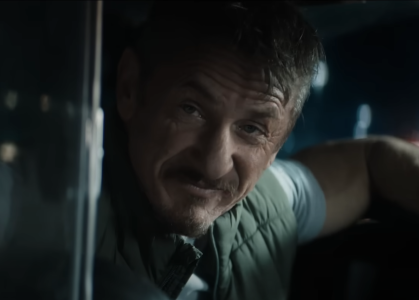 Really Nice Ride
Really Nice RideTo my great surprise and delight, Christy Hall‘s Daddio, which I was remiss in not seeing during last year’s Telluride...
More »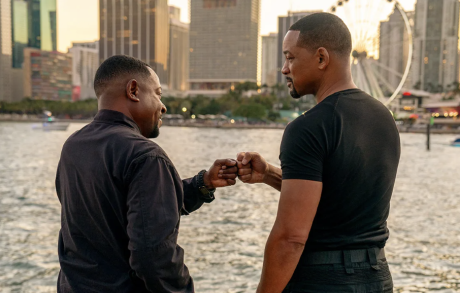 Live-Blogging “Bad Boys: Ride or Die”
Live-Blogging “Bad Boys: Ride or Die”7:45 pm: Okay, the initial light-hearted section (repartee, wedding, hospital, afterlife Joey Pants, healthy diet) was enjoyable, but Jesus, when...
More »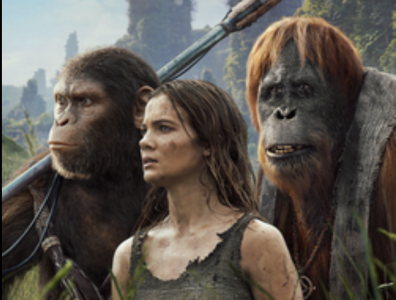 One of the Better Apes Franchise Flicks
One of the Better Apes Franchise FlicksIt took me a full month to see Wes Ball and Josh Friedman‘s Kingdom of the Planet of the Apes...
More »
- The Pull of Exceptional History
The Kamala surge is, I believe, mainly about two things — (a) people feeling lit up or joyful about being...
More » 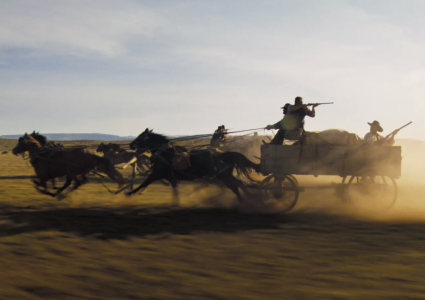 If I Was Costner, I’d Probably Throw In The Towel
If I Was Costner, I’d Probably Throw In The TowelUnless Part Two of Kevin Costner‘s Horizon (Warner Bros., 8.16) somehow improves upon the sluggish initial installment and delivers something...
More » Delicious, Demonic Otto Gross
Delicious, Demonic Otto GrossFor me, A Dangerous Method (2011) is David Cronenberg‘s tastiest and wickedest film — intense, sexually upfront and occasionally arousing...
More »


